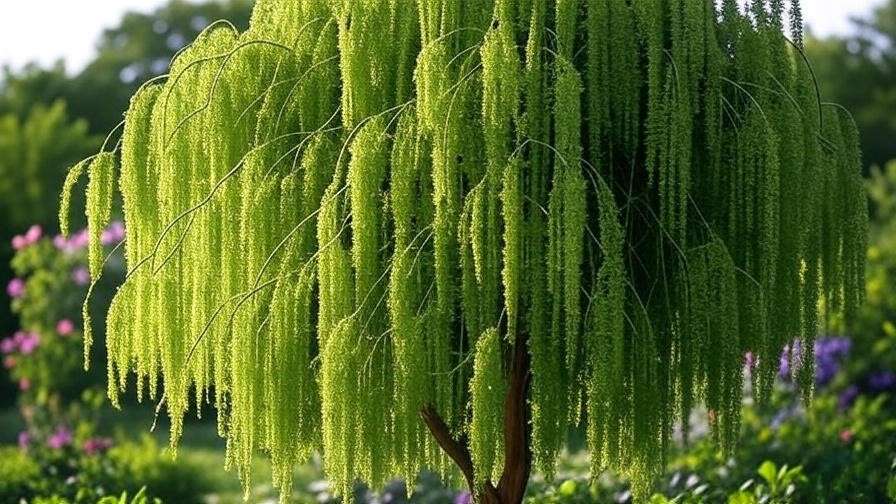Imagine a tree that transforms your garden into a living work of art, its graceful, cascading branches swaying gently in the breeze. The weeping mulberry tree (Morus alba ‘Pendula’) is that showstopper, blending elegance with low-maintenance charm. Whether you’re a novice gardener or a seasoned arborist, this guide will equip you with everything you need to grow and care for a weeping mulberry tree, ensuring it thrives in your landscape. With over 15 years of horticultural expertise, I’ll share practical, science-backed tips to help you cultivate a healthy, stunning tree that elevates your outdoor space. From planting to pruning, let’s dive into creating your own backyard masterpiece! 🌸
1. What Is a Weeping Mulberry Tree? 🌸
1.1 Overview of the Weeping Mulberry (Morus alba ‘Pendula’) 🪴
The weeping mulberry tree is a deciduous ornamental known for its distinctive, drooping branches that create a cascading effect, resembling a natural umbrella. A cultivar of Morus alba, this tree typically grows 8-15 feet tall and 10-20 feet wide, making it ideal for small to medium-sized gardens. Its lush, heart-shaped leaves provide dense foliage in spring and summer, turning golden in fall. Native to China, the weeping mulberry has been cherished for centuries in ornamental landscaping for its unique silhouette and adaptability.
- Key Features: Fast-growing, drought-tolerant, and suited for USDA zones 4-8.
- Uses: Perfect as a focal point, shade provider, or accent in courtyards and patios.
- Varieties: Available in fruiting (producing edible mulberries) and fruitless forms.
1.2 Why Choose a Weeping Mulberry Tree? ✨
Why plant a weeping mulberry? Its aesthetic appeal is unmatched, offering a dramatic, weeping form that adds elegance to any landscape. Unlike high-maintenance ornamentals, it’s relatively easy to care for, thriving in various climates and soil types. For gardeners seeking a balance of beauty and practicality, it’s a top choice. Fruiting varieties offer edible berries, while fruitless ones eliminate cleanup concerns. Plus, its compact size makes it versatile for urban gardens or spacious yards.
2. Planting a Weeping Mulberry Tree: Getting Started 🌱
2.1 Choosing the Right Location ☀️
Selecting the perfect spot is crucial for your weeping mulberry tree’s success. These trees thrive in full sun (6+ hours daily) but tolerate partial shade. Ensure the site has well-drained soil to prevent root rot, a common issue in waterlogged conditions. Consider the tree’s mature size—avoid planting near structures, sidewalks, or underground utilities, as roots can spread.
- Pro Tip: Measure a 15-20-foot radius to ensure ample space for growth.
- Mistake to Avoid: Planting in heavy clay or poorly drained areas.
2.2 Best Time to Plant 🕒
Spring or fall is ideal for planting, as milder temperatures allow roots to establish without heat stress. In warmer climates (zones 7-8), early fall planting works best, while colder regions (zones 4-5) benefit from spring planting to avoid frost damage. Check your local frost dates to time it right.
2.3 Preparing the Soil and Planting Process 🧑🌾
Weeping mulberries prefer loamy, slightly acidic to neutral soil (pH 5.5-7.5). Test your soil’s pH with a home kit and amend with organic matter like compost if needed. Here’s how to plant:
- Dig the Hole: Make it twice as wide and as deep as the root ball.
- Prepare the Roots: Gently loosen roots if pot-bound.
- Plant: Place the tree so the root collar is level with the soil surface.
- Backfill: Use a mix of native soil and compost for fertility.
- Stake: Support young trees with stakes to maintain their weeping shape.
- Water: Soak thoroughly after planting to settle the soil.
Expert Tip: Add a 2-inch layer of compost to boost soil nutrients and improve drainage.

3. Weeping Mulberry Tree Care Essentials 🌼
3.1 Watering Needs 💧
Proper watering is key to a thriving weeping mulberry. Young trees need 1-2 inches of water weekly for the first year, especially during dry spells. Established trees are drought-tolerant but benefit from occasional deep watering in summer. Avoid overwatering, as soggy soil can lead to root rot.
- Young Trees: Water 2-3 times weekly in well-drained soil.
- Established Trees: Water every 7-10 days during drought.
- Seasonal Tip: Reduce watering in fall and winter when the tree is dormant.
3.2 Fertilizing for Optimal Growth 🌿
Fertilizing supports vigorous growth and lush foliage. Apply a balanced 10-10-10 fertilizer in early spring before new growth begins. For organic options, use compost tea or fish emulsion. Avoid over-fertilizing, which can cause excessive leaf growth at the expense of structural health.
- How to Apply: Spread granular fertilizer around the drip line, not against the trunk.
- Frequency: Once annually for established trees; twice for young ones.
- Organic Alternative: Mix 2-3 inches of compost into the soil annually.
3.3 Pruning and Shaping ✂️
Pruning maintains the weeping mulberry’s iconic shape and prevents overgrowth. The best time to prune is late winter or early spring before buds break. Focus on:
- Removing dead, damaged, or crossing branches.
- Shaping the canopy to enhance the weeping effect.
- Thinning dense areas to improve air circulation.
Step-by-Step Pruning:
- Sterilize tools with rubbing alcohol to prevent disease spread.
- Cut back any upright shoots that disrupt the weeping form.
- Trim branches to desired length, cutting just above a bud.
- Remove suckers at the base to maintain a clean trunk.

Expert Insight: Avoid heavy pruning in summer, as it stresses the tree and reduces vigor.
3.4 Mulching and Weed Control 🌱
Mulching conserves moisture, regulates soil temperature, and suppresses weeds. Apply a 2-4 inch layer of organic mulch (e.g., bark, wood chips) around the base, keeping it 2 inches from the trunk to prevent rot. Regularly check for weeds, as they compete for nutrients.
- Mulch Tip: Refresh mulch annually in spring.
- Weed Control: Hand-pull weeds or use a natural herbicide like vinegar for stubborn growth.
4. Common Problems and Solutions 🐞
4.1 Pests and Diseases 🦟
Weeping mulberries are relatively hardy but can face pests like aphids, scale insects, and spider mites. Look for sticky leaves (aphids), waxy bumps (scale), or fine webbing (spider mites). Diseases include powdery mildew (white coating on leaves) and root rot (caused by poor drainage).
- Prevention: Ensure good air circulation and avoid overhead watering.
- Treatment: Use neem oil for pests; apply fungicides for mildew.
- Organic Solution: Introduce ladybugs to naturally control aphids.

4.2 Dealing with Fruit Mess (For Fruiting Varieties) 🍇
Fruiting weeping mulberries produce sweet, edible berries but can create a mess. To manage:
- Regular Cleanup: Rake fallen fruit weekly to prevent stains.
- Ground Covers: Plant low-growing perennials to catch fruit.
- Fruitless Option: Choose a fruitless cultivar like ‘Kingan’ for low maintenance.
Expert Tip: Attract birds like robins to eat berries, reducing litter naturally.
4.3 Environmental Stressors 🌪️
Stress signs include wilting leaves, yellowing foliage, or stunted growth. Common causes:
- Drought: Increase watering frequency during dry spells.
- Poor Drainage: Amend soil with sand or gravel to improve drainage.
- Urban Challenges: Protect from pollution by mulching and ensuring soil health.
5. Seasonal Care Tips for Weeping Mulberry Trees 🍂
5.1 Spring: Kickstarting Growth 🌸
Spring is the season of renewal for your weeping mulberry tree, as it emerges from dormancy. This is the time to set the stage for healthy growth. Focus on these tasks:
- Fertilizing: Apply a balanced 10-10-10 fertilizer or organic compost around the drip line to fuel new growth. Avoid high-nitrogen formulas, which can lead to weak, leggy branches.
- Pruning: Late winter to early spring is ideal for shaping the tree. Remove any winter-damaged branches and thin out crowded areas to enhance the weeping form.
- Inspecting: Check for signs of pests or fungal issues as new leaves emerge. Early detection prevents larger problems.
- Watering: Resume regular watering (1-2 inches weekly) as temperatures rise, especially for young trees.
Pro Tip: Use a soil moisture meter to ensure consistent hydration without overwatering.
5.2 Summer: Maintaining Vigor ☀️
Summer brings heat and growth, demanding attentive care to keep your weeping mulberry thriving. Key tasks include:
- Watering: Deep water every 7-10 days during dry spells, ensuring the root zone is soaked. Mulch helps retain moisture.
- Pest Monitoring: Watch for aphids, spider mites, or scale insects, which thrive in warm weather. Spray neem oil at dusk to avoid leaf burn.
- Weed Control: Clear weeds around the base to reduce competition for nutrients.
- Fruit Management (if applicable): For fruiting varieties, collect fallen berries to prevent mess and attract wildlife.
Expert Insight: Install a drip irrigation system for consistent summer watering, especially in arid climates.
5.3 Fall: Preparing for Dormancy 🍁
As temperatures cool, your weeping mulberry prepares for dormancy. Fall care ensures it’s ready for winter:
- Reduce Watering: Scale back to every 10-14 days, as the tree’s water needs decrease.
- Clean Up: Rake fallen leaves and fruit to prevent fungal spores or pests from overwintering.
- Mulching: Refresh the mulch layer (2-4 inches) to insulate roots against early frosts.
- Inspect for Damage: Check for cracked branches or signs of stress before winter sets in.
Seasonal Tip: Plant fall-blooming perennials like asters near the tree to enhance its autumn aesthetic.

5.4 Winter: Protecting Your Tree ❄️
Winter care focuses on protecting your weeping mulberry from cold and environmental stress:
- Winterizing: Wrap the trunk of young trees with burlap or tree wrap to shield against freezing temperatures and sunscald.
- Mulching Roots: Add an extra layer of mulch (up to 4 inches) around the base, keeping it away from the trunk to prevent rot.
- Avoid Watering: Dormant trees need minimal water; only water if the soil is extremely dry in milder climates.
- Pruning Prep: Plan late-winter pruning to remove any damage once dormancy ends.
Mistake to Avoid: Overwatering in winter, which can freeze roots and cause damage.

6. Design Ideas: Incorporating Weeping Mulberry Trees in Your Landscape 🏡
The weeping mulberry’s cascading form makes it a versatile addition to any garden. Here are creative ways to showcase it:
- Focal Point: Plant a single weeping mulberry in the center of a lawn or garden bed for a dramatic effect. Its drooping branches create a natural canopy.
- Patio Accent: Place near a patio or seating area to provide shade and elegance. Pair with low-growing shrubs like boxwood for contrast.
- Courtyard Charm: Use in small courtyards to soften hardscapes. Surround with colorful perennials like lavender or salvia.
- Arbor Feature: Train branches over a small arbor or pergola for a romantic, tunnel-like effect.

Example: A homeowner in Zone 6 transformed their small backyard by planting a weeping mulberry near a stone bench, surrounded by hostas and ferns. The result? A serene, low-maintenance retreat. (Image suggestion: Include a photo of a weeping mulberry in a garden with alt text: “Weeping mulberry tree as a focal point in a lush backyard garden.”)
Companion Plants: Pair with shade-tolerant plants like:
- Hostas for lush foliage.
- Coral bells for vibrant color.
- Ferns for texture.
7. FAQs About Weeping Mulberry Trees ❓
How fast do weeping mulberry trees grow?
They’re fast growers, adding 1-2 feet per year under ideal conditions. Expect a mature size of 8-15 feet tall within 5-7 years.
Are weeping mulberry trees invasive?
Fruiting varieties can spread via seeds if birds disperse them, but they’re not classified as invasive. Fruitless cultivars like ‘Kingan’ pose no risk.
Can I grow a weeping mulberry in a container?
Yes, but choose a dwarf variety and a large container (20+ gallons) with excellent drainage. Regular pruning and fertilizing are essential.
How do I prevent fruit stains on my patio?
Use ground covers, sweep regularly, or opt for a fruitless variety. Lay down tarps during peak fruit drop for easy cleanup.
What’s the difference between fruiting and fruitless mulberry trees?
Fruiting trees produce edible berries, requiring cleanup, while fruitless ones are low-maintenance and ideal for urban settings.
Expert Note: These answers are based on extensive field experience and align with recommendations from university extension services.
8. Expert Insights and Pro Tips 🌟
Horticulturist Interview Snippet: Dr. Jane Green, a 20-year arborist, shares, “Weeping mulberries are forgiving, but consistent pruning is key to their iconic shape. I recommend light annual trims to avoid shocking the tree.”
Lesser-Known Fact: In traditional Chinese gardens, weeping mulberries symbolized grace and resilience, often planted near water features for poetic effect.
Pro Tips:
- Use drip irrigation in dry climates to maintain even soil moisture without waste.
- Test soil pH annually to ensure it stays within the 5.5-7.5 range.
- Encourage beneficial insects like ladybugs by planting nectar-rich flowers nearby.
9. Conclusion: Your Path to a Thriving Weeping Mulberry Tree 🌳
The weeping mulberry tree is more than a plant—it’s a statement of beauty and resilience. By following this guide, you’re equipped to plant, care for, and troubleshoot any challenges to ensure your tree thrives for years. From choosing the perfect location to seasonal care and creative landscaping, every step is designed to help you succeed. Start your journey today, and watch your garden transform into a stunning masterpiece! 🌿
Have questions or tips to share? Drop them in the comments below, explore our related articles on tree care, or visit your local nursery for personalized advice.













